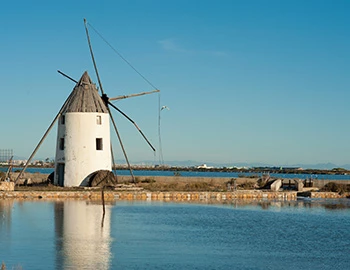Sicilia
Sicily: more than a wine island
The largest island in the Mediterranean has a greater variety and history of wine to offer than many wine-growing countries. The focus of this interest rests on the full, fruity, yet well-structured wines from the long-neglected red Nero d'Avola variety, and on the wholesome Catarratto white wines. In addition, two legendary wines are experiencing a well-deserved renaissance: the liqueur wines from Marsala and the growths from Mount Etna, with their impressive crispness and complexity.
Red wines from Sicilia
Hardly anyone would suspect that more white wines are produced in Sicily than reds. But the island has a whole range of white varieties that have adapted perfectly to the hot climate. This also applies to the Catarratto bianco, the most-planted variety in Sicily. Ambitious winemakers vinify aromatic wines of moderate body with extremely prominent, fresh acidity from the late-ripening grapes. Blindly tasting a congenial Catarratto, one would hardly conclude that such a lively white wine can be grown Europe’s southernmost reaches. They are perfect accompaniments to a variety of Sicilian seafood dishes.
Greek influences
The southern apex of Sicily lies somewhat further south than the Tunisian capital, Tunis. In antiquity, the island was an important part of Greater Greece, and the beginnings of viticulture reach back to this period. Nowhere is the Greek influence as strong as in the south-eastern tip of the island, close to the Baroque town of Noto, where the leading red variety, Nero d'Avola, yields the best results. The bushy vines are rooted here in pure, very fine-grained limestone soils so light in colour that they reflect the light of a full moon. Dark-coloured wines originate here that, despite their fruit body, do not lack for structure and crispness.
New Crus from Etna
Around 150,000 hectares are planted with vines in Sicily. The climate is pronouncedly Mediterranean. In August, temperatures well over 40 degrees Celsius are common. On the other hand, the peak of Mount Etna is covered with snow for a large part of the year. The soils are extraordinarily diverse. The spectrum ranges from the pure limestone soils in the southeast, to the sparse volcanic soils of Mount Etna, to the nutrient-rich terroir of the interior. Many well-known Sicilian producers have successfully cultivated international varieties like Merlot and Chardonnay in the last 20 years, but interest is shifting back to the native grape and wine varieties.
The best evidence for this is the renaissance of Marsala wines, whose image in the intervening years has fallen to the level of a cooking wine. They are available both as dry aperitif wines (“vergine”), as well as in the “semisecco” and “dolce” variants. The best Marsalas mature for years in barrels and are impressively rich. Wines from Mount Etna are also experiencing a simply spectacular upturn, with old varieties like the red Nerello Muscalese and the white Carricante cultivated at elevations up to 1,000 metres above sea level, yielding highly elegant wines.







